manual transmission OLDSMOBILE BRAVADA 1998 Owners Manual
[x] Cancel search | Manufacturer: OLDSMOBILE, Model Year: 1998, Model line: BRAVADA, Model: OLDSMOBILE BRAVADA 1998Pages: 380, PDF Size: 19.2 MB
Page 65 of 380
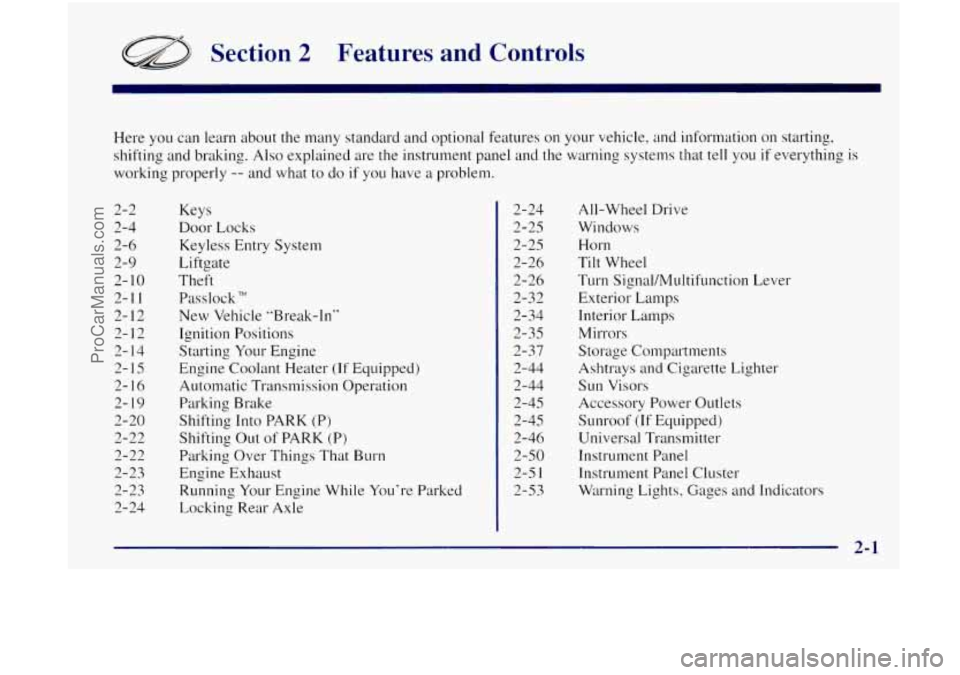
a Section 2 Features and Controls
Here you can learn about the many standard and optional features on your vehicle, and information on starting,
shifting and braking. Also explained are
the instrument panel and the warning systems that tell you if everything is
working properly
-- and what to do if you have a problem.
2-2
2-4
2-6
2-9
2-
10
2-1 1
2- 12 2- 12
2- 14
2- 15
2-16
2- 19
2-20
2-22
2-22
2-23
2-23
2- 24 Keys
Door Locks
Keyless Entry System
Liftgate
Theft Passlock
TM
New Vehicle “Break-In”
Ignition Positions
Starting Your Engine
Engine Coolant Heater
(If Equipped)
Automatic Transmission Operation
Parking Brake
Shifting Into PARK
(P)
Shifting Out of PARK (P)
Parking Over Things That Burn
Engine Exhaust
Running Your Engine While You’re Parked
Locking Rear Axle 2-24
2-25
2-25
2-26
2-26
2-32 2-34
2-35
2-37 2-44
2-44
2-45
2-45 2-46
2-50
2-5
1
2-53 All-Wheel Drive
Windows Horn
Tilt Wheel
Turn Signal/Multifunction Lever
Exterior Lamps
Interior Lamps
Mirrors
Storage Compartments Ashtrays and Cigarette Lighter
Sun Visors
Accessory Power Outlets
Sunroof (If Equipped)
Universal Transmitter Instrument Panel
Instrument Panel Cluster
Warning Lights, Gages and Indicators
ProCarManuals.com
Page 71 of 380

Operation
When you press UNLOCK. the driver's door will
unlock automatically, the parking lamps will flash and
the interior lights will go on.
If you press UNLOCK
again
within three seconds, the remaining doors will
unlock, the parking lamps will flash and the interior
lights
will go on. Press LOCK to lock all the doors.
Press LOCK again and the horn will chirp.
Press the
REAR button twice within three seconds to
unlock the rear liftgate glass, the parking larnps will
flash and the interior lights will go on. The transmission
must be
in PARK (P) or NEUTRAL (N).
Remote Panic Alarm
When the button with the horn symbol on the key
transmitter
is pressed, the horn will sound and the
headlamps and taillamps will flash for
up to two
minutes. This can
be turned off by pressing the
horn button again, waiting for 30 seconds, or
starting the vehicle.
Matching Transmitter(s) To Your Vehicle
Each remote keyless entry transmitter is coded to
prevent another transmitter from unlocking your vehicle.
If a transmitter is lost or stolen, a replacement can be purchased through your retailer. Remember
to bring
any
remaining transmitters
with you when you go to your
retailer. When the retailer matches the replacement
transmitter
to your vehicle. any remaining transmitters
must
also be matched. Once your retailer has coded the
new transmitter, the lost transmitter will
not unlock youI
vehicle.
Each vehicle can have only two transmitters
matched
to it.
Battery Replacement
Under normal use, the battery in your remote keyless
entry transmitter should
last about two years.
You can tell the battery is weak
if the transmitter won't
work at the normal range
in any location. If you have to
get close to your vehicle before the transmitter works,
it's probably time
to change the battery.
I NOTICE:
When replacing the battery, use em nat to touch
any of the circuitry. Static from your body
transferred to these surfaces may damage
the transmitter.
2-7
ProCarManuals.com
Page 74 of 380
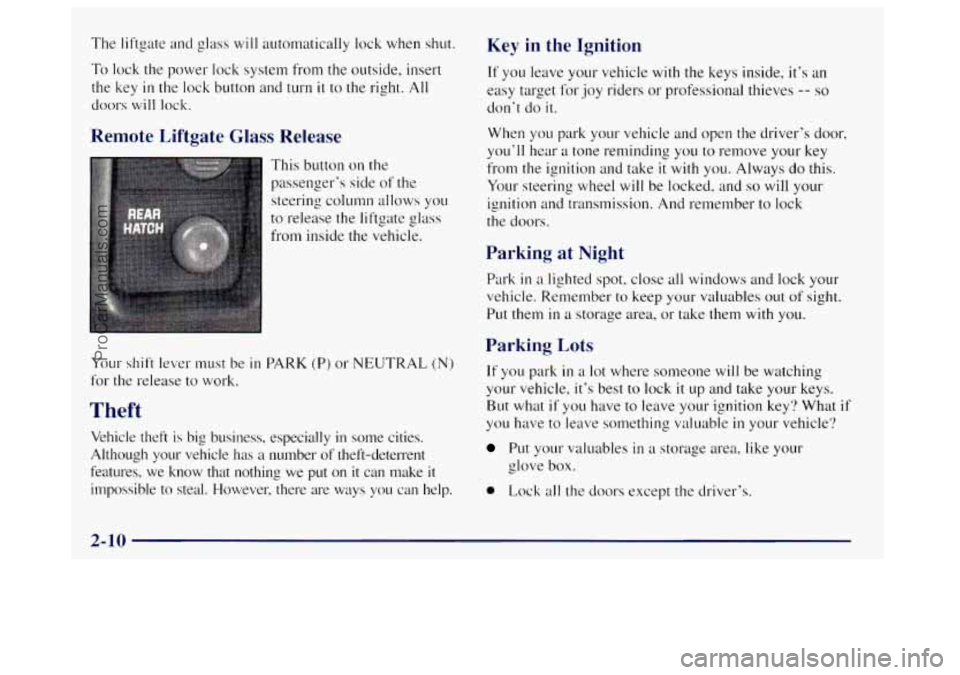
The liftgate and glass will automatically lock when shut.
To
lock the power lock system from the outside, insert
the key
in the lock button and turn it to the right. All
doors will lock.
Remote Liftgate Glass Release
This button on the
passenger’s side
of the
steering column allows you
to release the liftgate glass
from inside
the vehicle.
Key in the Ignition
If you leave your vehicle with the keys inside, it’s an
easy target for joy riders or professional thieves
-- so
don’t do it.
When you park your vehicle and open the driver’s door,
you’ll hear
a tone reminding you to remove your key
from the ignition
and take it with you. Always do this.
Your steering wheel
will be locked, and so will your
ignition and transmission. And remember to lock
the doors.
Parking at Night
Park in a lighted spot, close all windows and lock your
vehicle. Remember
to keep your valuables out of sight.
Put
them in a storage area, or take them with you.
Your shift lever must be
in PARK (P) or NEUTRAL (N)
for the release to work.
Theft
Vehicle theft is big business, especially in some cities.
Although your vehicle
has a number of theft-deterrent
features, we know that nothing we put
on it can make it
impossible to steal. However, there are ways you can help.
Parking Lots
If you park in a lot where someone will be watching
your vehicle, it’s best to lock
it up and take your keys.
But what
if you have to leave your ignition key‘? What if
you have to leave something valuable in your vehicle?
Put your valuables in a storage area, like your
glove box.
0 Lock all the doors except the driver’s.
2-10
ProCarManuals.com
Page 77 of 380
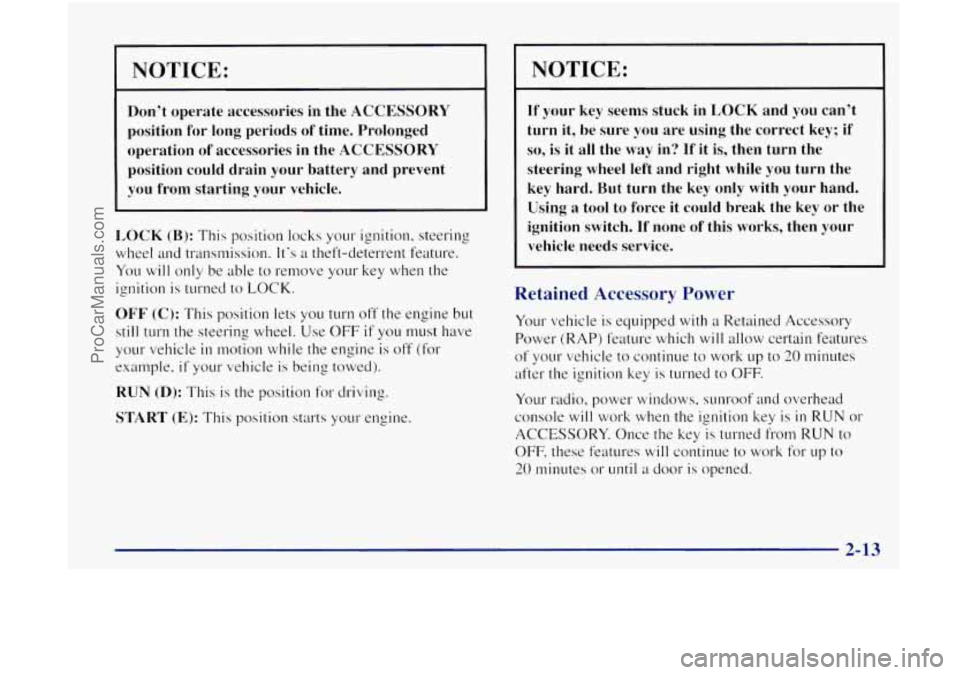
NOTICE:
Don’t operate accessories in the ACCESSORY
position for long periods of time. Prolonged
operation of accessories in the
ACCESSORY
position could drain your battery and prevent
you from starting your vehicle.
LOCK (B): This position locks your ignition, steering
wheel and transmission. It’s
a theft-deterrent feature.
You will only be able to remove your key when the
ignition is turned to
LOCK.
OFF (C): This position lets you turn off the engine but
still turn the steering wheel. Use
OFF if you must have
your vehicle
in motion while the engine is off (for
example,
if your vehicle is being towed).
RUN (D): This is the position for driving.
START (E): This position starts your engine.
NOTICE:
If your key seems stuck in LOCK and you can’t
turn it, be sure you are using the correct key; if
so, is it all the way in? If it is, then turn the
steering wheel left and right while you turn the
key hard. But turn the key only with your hand.
Using
a tool to force it could break the key or the
ignition switch.
If none of this works, then your
vehicle needs service.
Retained Accessory Power
Your vehicle is equipped with a Retained Accessory
Power (RAP) feature which will allow certain features
of your vehicle to continue to work up to 20 minutes
after the ignition
key is turned to OFF.
Your radio, power windows, sunroof and overhead
console
will work when the ignition key is in RUN or
ACCESSORY. Once the key is turned from
RUN to
OFF, these ,features will continue to work for up to
20 minutes or until a door is opened.
ProCarManuals.com
Page 78 of 380

Starting Your Engine
Move your shift lever to PARK (P) or NEUTRAL (N).
Your engine won’t start in any other position -- that‘s a
safety feature. To restart when you’re already moving,
use NEUTRAL
(N) only.
NOTICE:
Don’t try to shift to PARK (P) if your vehicle is
moving. If you do, you could damage the
transmission. Shift to PARK
(P) only when your
vehicle is stopped.
1. Without pushing the accelerator pedal. turn your
ignition key to START. When the engine starts. let
engine gets warm.
2 *o of the key. The idle speed will go down as your
NOTICE:
Holding your key in START for longer than 15
seconds at a time will cause your battery to be
drained much sooner. And the excessive heat can
damage your starter motor.
2. If it doesn’t start right away, hold your key in
START. If it doesn’t start in 10 seconds, push the
accelerator pedal all the way down for five more
seconds, or
until it starts.
3. If your engine still won’t start (or starts but then
stops), wait
15 seconds and start over.
When the engine starts, let
go of the key and the
accelerator pedal.
NOTICE:
Your engine is designed to work with the
electronics
in your vehicle. If you add electrical
parts or accessories, you could change the
way
the engine operates. Before adding electrical
equipment, check with your retailer. If you don’t,
your engine might not perform properly.
If you ever have to have your vehicle towed, see
the part of’this manual that tells how to
do it
without damaging your vehicle. See “Towing
Your Vehicle” in the Index.
2-14
ProCarManuals.com
Page 80 of 380
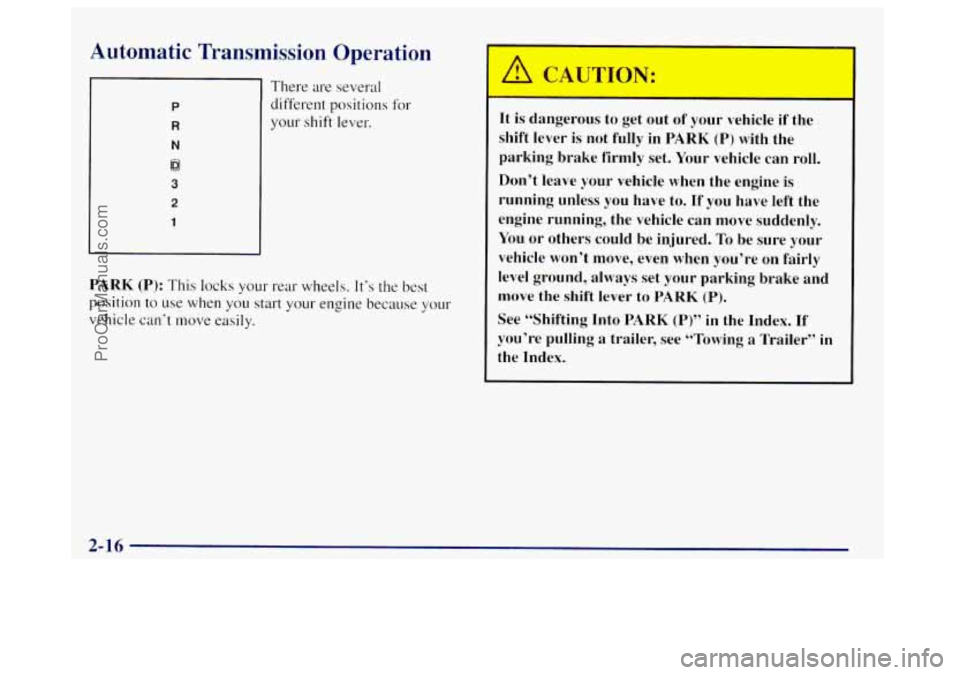
Automatic Transmission Operation
P
R
N
0
3
2
1
There are several
different positions for
your shift lever.
PARK (P): This locks your rear wheels. It’s the best
position to use when you start your engine because your
vehicle
can‘t move easily.
r
It is dangerous to get out of your vehicle if the
shift lever
is not fully in PARK (P) with the
parking brake firmly set. Your vehicle can roll.
Don’t leave your vehicle when the engine is
running unless you have to. If you have left the
engine running, the vehicle can move suddenly.
You or others could be injured. To be sure your
vehicle won’t move, even when you’re
on fairly
level ground, always set your parking brake and
move the shift lever to
PARK (P).
See “Shifting Into PARK (P)” in the Index. If
you’re pulling
a trailer, see “Towing a Trailer” in
the Index.
ProCarManuals.com
Page 81 of 380

EIISLW the shift lever is f~~lly in PARK (P) range
before starting the engine. Your vehicle has
a
Brake-Transmission Shift Interlock (BTSI). You
have to fully apply your regular brakes before you can
shift from PARK
(P) when the ignition key is in RUN.
If you cannot shift out of PARK (P), ease pressure on
the shift lever -- press the button on the shift lever and
push the shift lever
all the way into PARK (P) as you
maintain brake application. Then move the shift lever
into the gear you wish. See ”Shifting Out of PARK (P)”
in the Index.
REVERSE (R): Use this gear to back up.
NOTICE:
Shifting to REVERSE (R) while your vehicle is
moving forward could damage your
transmission. Shift
to REVERSE (R) only after
your vehicle
is stopped.
To rock your vehicle back and forth to get out of snow,
ice or sand without damaging your transmission, see
”Stuck:
In Sand, Mud, Ice or Snow’‘ in the Index.
NEUTRAL (N): In this position, your engine doesn’t
connect
with the wheels. To restart when you’re already
moving, use NEUTRAL (N) only.
Shifting out
of PARK (P) or NEUTRAL (N) while
your engine
is “racing” (running at high speed) is
dangerous. Unless your foot
is firmly on the
brake pedal, your vehicle could move very
rapidly. You could lose control and hit people or
objects. Don’t shift out of
PARK (P) or
NEUTRAL (N) while your engine is racing.
I NOTICE:
Damage to your transmission caused by shifting
out of
PARK (P) or NEUTRAL (N) with the
engine racing isn’t covered by your warranty.
ProCarManuals.com
Page 82 of 380
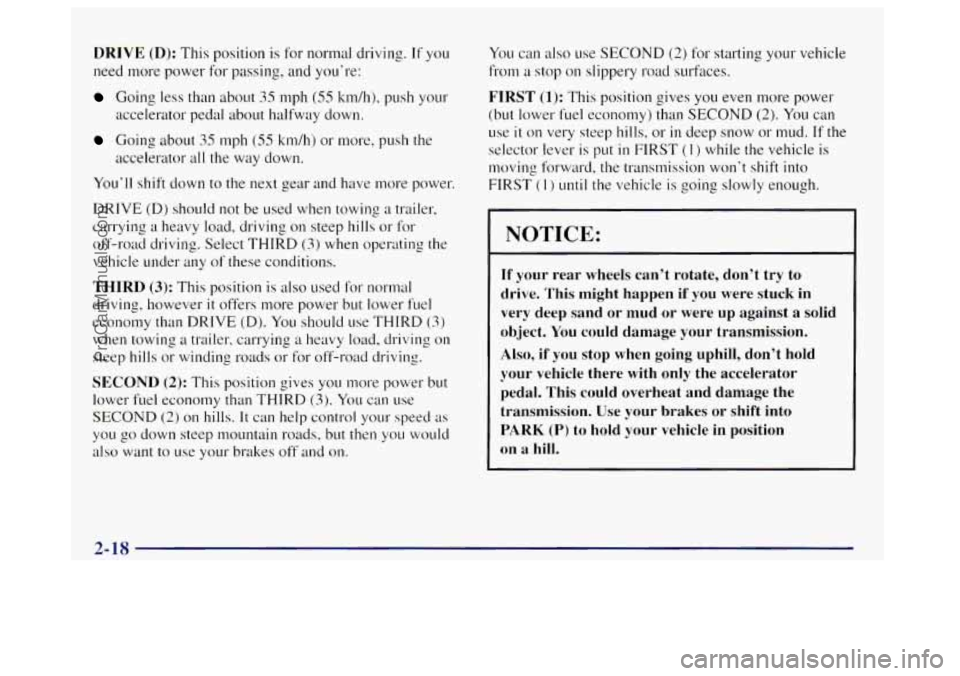
DRIVE (D): This position is for normal driving. If you
need more power for passing, and you’re:
Going less than about 35 mph (5.5 km/h), push your
accelerator pedal about halfway down.
Going about 3.5 mph (5.5 km/h) or more, push the
accelerator all the way down.
You’ll shift down to
the next gear and have more power.
DRIVE (D) should not be used when towing
a trailer,
carrying a heavy load, driving on steep hills or for
off-road driving. Select THIRD
(3) when operating the
vehicle under any of these conditions.
THIRD (3): This position is also used for nornlal
driving, however
it offers more power but lower fuel
economy than DRIVE (D). You should use THIRD
(3)
when towing a trailer, carrying a heavy load, driving on
steep hills or winding roads or for off-road driving.
SECOND (2): This position gives you more power but
lower fuel economy than THIRD
(3). You can use
SECOND
(2) on hills. It can help control your speed as
you go down steep mountain roads, but then you would
also want to use your brakes off and on. You
can also use SECOND
(2) for starting your vehicle
from a stop
on slippery road surfaces.
FIRST (1): This position gives you even more power
(but lower fuel economy) than SECOND
(2). You can
use
it on very steep hills, or in deep snow or mud. If the
selector lever
is put in FIRST (I ) while the vehicle is
moving forward, the transmission won’t shift into
FIRST
(1) until the vehicle is going slowly enough.
-
NOTICE:
If your rear wheels can’t rotate, don’t try to
drive. This might happen if
you were stuck in
very deep sand or mud or were up against a solid
object.
You could damage your transmission.
Also, if you stop when going uphill, don’t hold
your vehicle there with only the accelerator
pedal. This could overheat and damage the
transmission. Use your brakes or shift into
PARK (P) to hold your vehicle in position
on a hill.
2-18
ProCarManuals.com
Page 85 of 380

Leaving Your Vehicle With the
Engine
Running
4 CAUTION:
It can be dangerous to leave your vehicle with the
engine running. Your vehicle could move
suddenly if the shift lever is not fully in PARK
(P)
with the parking brake firmly set. And, if you
leave the vehicle with the engine running, it could
overheat and even catch fire. You or others could
be injured. Don’t leave your vehicle with the
engine running unless you have to.
If you have to leave your vehicle with the engine
running, be sure your vehicle is
in PARK (P) and your
parking brake is firmly set before you leave
it. After
you‘ve moved the shift lever into PARK (P), hold the
regular brake pedal down. Then, see
if you can move the
shift lever away from PARK (P) without first pulling it
toward you (or pressing the button on a console shift
lever).
If you can, it means that the shift lever wasn’t
fully locked into PARK (P).
Torque Lock
If you are parking on a hill and you don’t shift your
transmission into PARK (P) properly, the weight of the
vehicle may
put too much force on the parking pawl in
the transmission. You may find it difficult to pull the
shift lever out of PARK (P). This
is called “torque lock.”
To prevent torque lock, set the parking brake and then
shift into PARK (P) properly before you leave the
driver’s seat.
To find out how, see “Shifting Into
PARK
(P)” in the Index.
When you are ready
to drive, move the shift lever out of
PARK
(P) bqjot-e you release the parking brake.
If torque lock does occur, you may need to have another
vehicle push yours a little
uphill to take some of the
pressure
f1-0111 the parking pawl in the transmission, so
you can pull the shift lever out of PARK (P).
2-21
ProCarManuals.com
Page 86 of 380
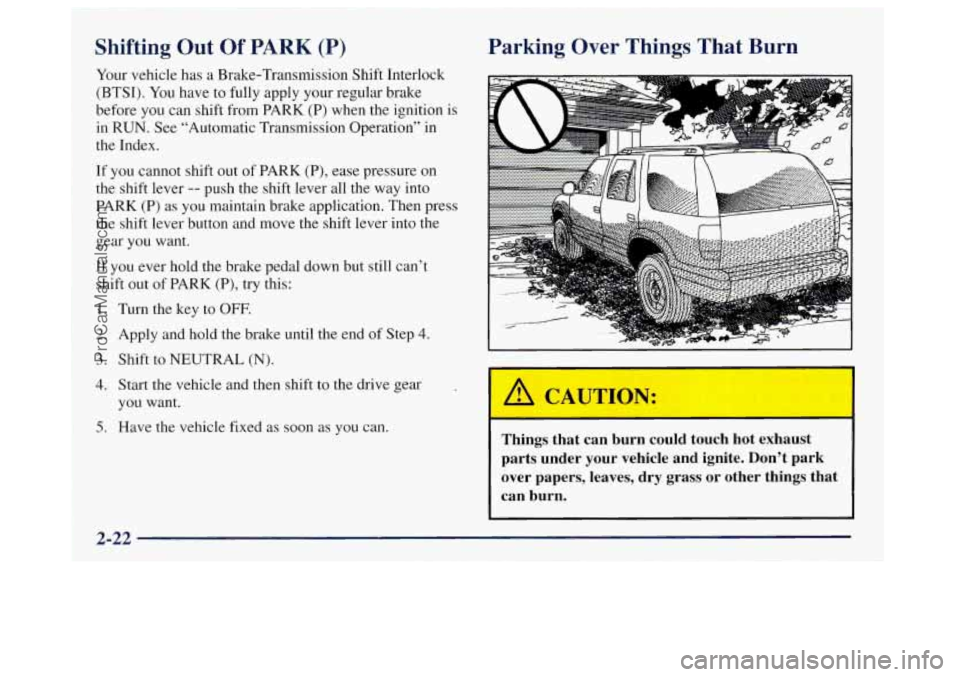
Shifting Out Of PARK (P)
Your vehicle has a Brake-Transmission Shift Interlock
(BTSI).
You have to fully apply your regular brake
before
you can shift from PARK (P) when the ignition is
in
RUN. See “Automatic Transmission Operation” in
the Index.
If you cannot shift out of PARK
(P), ease pressure on
the shift lever
-- push the shift lever all the way into
PARK
(P) as you maintain brake application. Then press
the shift lever button and move the shift lever into the
gear you want.
If you ever hold the brake pedal down but still can’t
shift
out of PARK (P), try this:
1. Turn the key to OFF.
2. Apply and hold the brake until the end of Step 4.
3. Shift to NEUTRAL (N).
4. Start the vehicle and then shift to the drive gear
you want.
5. Have the vehicle fixed as soon as you can.
Parking Over Things That Burn
I I
Things that can burn could touch hot exhaust
parts under your vehicle and ignite. Don’t park
over papers, leaves, dry grass or other things that
can burn.
2-22
ProCarManuals.com